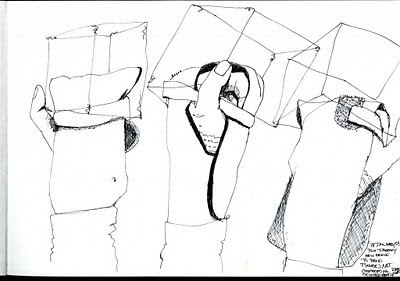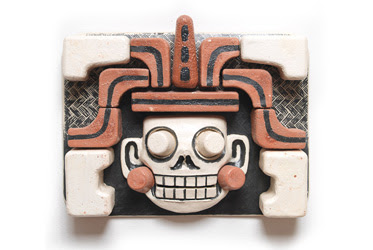(To learn more about the “Viewfinder Project” see the original post.)
The Winter Solstice will take place (Thursday December 22, 2011) in a little over a month. This has allowed me to consider the qualities of darkness and its psychological range. Darkness will often illicit fear because it obscures sight and represents the unknown. However, darkness also provides the critical function of allowing the eyes to rest. Any relationship with light is bound to darkness (In a broader philosophical way this is expressed in yin and yang). This can become apparent when people pray. Often one’s eyes are closed, in this case putting oneself in darkness, in order to find an inner light.
Julie Mecoli’s “Viewfinder” (seen below) presents darkness in a multifaceted way. It contains cultural references and a range of material applications. She explained to me that this piece reveals a view from her bathroom window of a cathedral. Cathedrals were built to bring in light through stain glass windows and to present devinity through architecture. Ironically, light often casts the exterior of these buildings as a less colorful compared to the surroundings.
 |
| Julie Mecoli, Viewfinder, 4 1/4 inches x 6 inches, (Media: ink, photocopy, tape), 2006 |
Another element in Mecoli’s “Viewfinder” is the portrait. In this case it is self-portraiture developed from observational drawings made using her bathroom mirror. Julie begins by making daily drawings on post-it notes. Then she photocopies them so that one portrait overlaps the next. This means that she feeds the same piece of paper through the copy machine multiple times. Thus, eventually the features of the figure begin to vanish into darkness. Julie told me that the copier can only take this procedure 10 times before it jams.
The layering process that occurs demonstrates how self observation can be intense and at times be destructive while also being a force for positive creative self realization. The portrait is but a representation of one side of ourselves and these portraits serve as reminder that we have a being and a likeness even in darkness.
 |
| Julie Mecoli, Dark Matter Gateway, 34cm x 16cm x 4cm, cast bitumen, 2009 |
Many of Mecoli’s other works feature a contrast between dark and light including a series of sculptures cast in bitumen (an example is seen above). These sculptures slowly change form over time and serve as a reminder that no matter how solid a form or idea it is subject to change depending on the right conditions. Julie has also made a series of drawings and blog posts related to the rehabilitation of her hand (one is featured below). Several of her fingers were crushed in an accident. I am happy to report that Julie is on the mend but do check out her drawings and writing.
 |
| Julie Mecoli, 18 January 2010 Post therapy New device to Bend fingers not cooperating crushed hand + wire cube |





